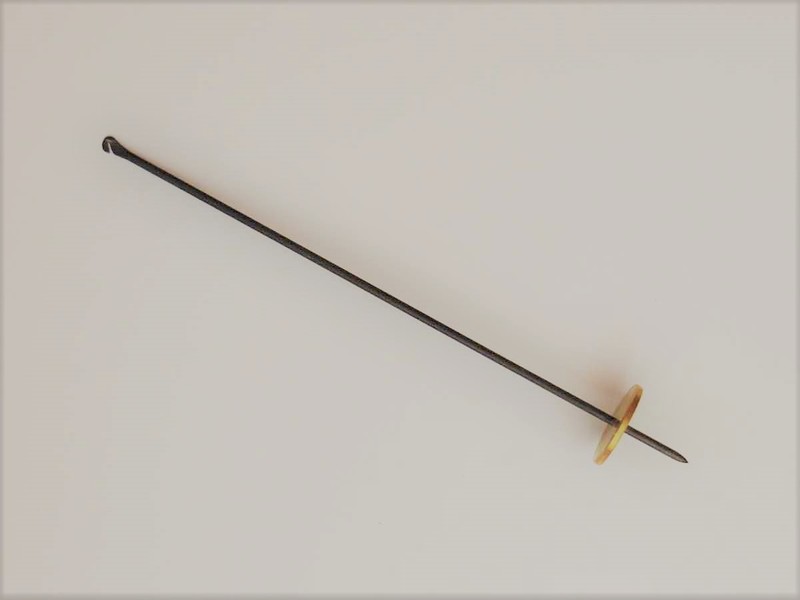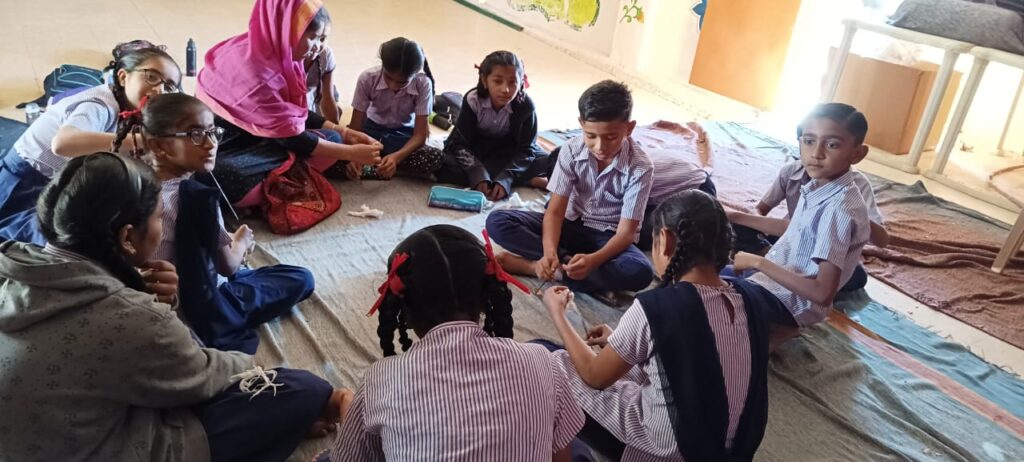Waking up by 7:00 AM is my definition of waking up early. The morning follows its motions. A bath to freshen up the body, a book to gently wake up the mind, and a cup of warm tea to bring ease and lubricate all the cogs in me. And with this reawakened self I leave for work. Every day I take a bus to work that leaves by 9:30 AM.
It is a Monday. Monday means that there is a session at the Bhujodi school at 10:00 AM. The Khamir campus is an 11-kilometer drive and Bhujodi will come on our way a little past the halfway point. The driver stops the bus on the side of the highway and my colleagues, Rushikesh, Krishna, and I get off. A final half-kilometer walk and here we are at the ‘Shri Bhujodi Prathmik Shala’.

The school only starts after 10:45 AM. There is already a small group of 8 -10 children waiting for us when we reach. Some good morning greetings, some catching up and discussing weekend whereabouts. And a funny question, sometimes about my week, sometimes about a film or some Youtuber. And sometimes about where I am from. A little exchange every time we see each other. Them telling me about something that they saw and me telling them about what I think of it. Over weeks both parties learning a little more about each other.
We sit in a circle, everyone takes a takli from the box and the session begins. The takli is a spindle, it is a slender rod with a pointed tip and a tapered almost hook-like top. It is used in the hand spinning of yarn. It allows one to make thread from cotton or wool. As the takli rotates it twists together the fibers in the cotton. Allowing one to make a thread with something that fits in your pencil case. An activity called spinning. Every Monday morning we sit with a group of approximately 8 children. We spin in the 30-40 minutes before the prayer begins.


More conversations ensue, some laughing, some pulling leg, a lot more Gujarati and Kachchhi compared to the greetings of the morning. And in the middle of all the anecdotes, jokes, and horsing around, long silences as the group concentrates on their yarn.
The takli is similar to the charkha, a tool that requires your attention and focus. Spinning the takli is a game of balance. Balancing the rotations of the spindle and the amount we pull the mass of cotton in our other hand. A constant dance, a very gentle one. Simply called ‘practice’. This once-a-week 30-minute session before school is where the kids and us from the Khamir team sit and spin.
Post prayer it is time for the class. A one-hour session that we have been permitted to conduct within the school hours.
So what is this class? What is this project? What is with the takli? And why spinning?
I work with Khamir. We are an organization that works towards the preservation and sustenance of craft knowledge and livelihoods. My role is primarily part of the Craft Curriculum Project. Here we are trying to build a crafts-based curriculum for schools.
Kachchh has for a long time been known for its skilled artisans and the many trades that prospered. It still does today, through the muscle of man and the skills of the hands. The education that many of us receive does not let us see value in this work. With this project, we hope to find intersections between the craft practices that we see in Kachchh, the NCERT learning outcomes, and the many values and traditional knowledge systems that exist in our surroundings.
How can we create a more enriching learning experience?
Can we bring in class the joy of working with our hands?
How can the two work hand in hand?
Giving an example, just two weeks ago the children were trying to make their own taklis from junk. They tried using different sticks, different shapes for the circular portion, using different diameters, different positions, etc. All with one goal in mind – how can they make a takli that can spin the best?
In this process we were defining in class what means ‘best’ for them, is it the speed of rotation? Is it the duration? Is it how steady the takli spins? Then with the experimenting and the practice of spinning different groups in the class came down to theories about why one takli works better than the other and what would help improve a takli.
The children made observations of various kinds of characteristics mentioned above. The role of a teacher here is to bring these observations out in dialogue. To engage the children in conversation with the teacher and among themselves. Later in the day, connect what is there in their textbooks to the activities that they have been a part of. The problems that they have tried to solve and understand with their own two hands and minds.
Or a session where a master potter came to visit the class. We were showing the children images of different pots and he was able tell which village a pot was made in. He went on to speak to the kids about the relationships between different local communities and how the economics and exchange worked in earlier times. He also spoke about how by the color of the clay and designs on the pot you can gauge where and for which community it was made, how and why pots for different utility are made with different features and why the potter uses only natural colors to ornament his pots in a day where paints are easily available. Helping us and the kids understand the world of pottery, Kachchh and our society a little better.
Today we were going to discuss what the class will do next. The children were all telling us their ideas and we were thinking of different directions that the class could go in. During the session, I hear whispers from our coordinator and the teachers about a few parents who have come to school. Something about this commotion and whispering seemed odd. By then I’d put two and two together and made sense of the conversation. They have come to observe the sessions. This would be the first time a group of parents would be doing this. In my head, it is only natural for a parent to wish to meet a group of people who take these sessions with their kids that they keep hearing about.
I step out of class for a second and I hear loud conversation from the principal’s room. The open courtyard of the school barely kept voices and activity from one room reaching the rest of the compound. Moving closer to its source, the principal’s room. I see half a dozen pairs of slippers lined up outside and what seemed to be a loud conversation when looked at clearly was a very heated one.
A man speaking loudly, in his voice accusation, and the principal only slightly softer than him, in his voice defense. A woman interjecting, almost screaming and the group humming along. What was a loud conversation slowly sounded like an argument and one that would soon become a fight. All the Kachchhi going over my head, the tension and heat of the moment a little overwhelming, and my recognition of the only word I could pick up was…Khamir.
Choosing not to enter the conversation without knowing how it began and how it got where it did, I returned to the class and resumed the session. Within 5 minutes the principal’s office fails to contain the guests. The parents then march over to the classroom where I was standing. The principal and a few teachers behind them trying to speak, trying to reason.
Who are you?
What are you trying to do?
We send our kids here to study! Not for this. Why are you wasting their time.
Shut this! My Kids won’t be a part of this!
All of this and many more things get said. I start explaining to individual members of the group what the project is and what it tries to do. The principal and the teachers stand with me in support. As we stand outside and talk one by one the parents go into the classroom and ask the kids about what they are doing and if they are having fun. Being able to speak to the parents one-on-one and seeing the kids’ excitement regarding the session led to the heated crowd calming down and the parents slowly in favor and open to listen.
The one person who was raising his voice however didn’t speak to me. He told me that this activity is a waste of time. That his daughter won’t sit for these sessions and he walked away. No clarification, no explanation, no conversation. While speaking to the other parents I could see him leave through the main gate of the school.
Forty minutes of a Monday morning.
Back at the office, the entire incident gets discussed. Everyone was a little shocked and a little relieved. Things could have gotten a lot more out of hand. From apprehensions in the community about the project to reasons pertaining to traditional practices. The woman that was against the work was not against the activity, not against spinning.
Being a Rabari who are herders and spinners of wool she didn’t like her granddaughter spinning with something that looked like a toy. If it is to be taught, it should be the traditional way, she argued. Something that I can understand but her stance to opposition I couldn’t. A point that gets channelized in screaming at a school principal and trying to stop the work of an organization makes me wonder if there is more to her sentiment.
Plans get made to address the situation. To increase our engagement with parents, to conduct workshops, to be part of parent-teacher meetings. There is support from the school and there is support from some parents. Communication needs to be strengthened and work needs to be more structured. The way forward is decided. The situation for now is dusted.
I go to school every week and one student is not in my class. We pull out our tools, we do our activities. We continue with the session plans and the module moves forward one week at a time.
One student, however, sits in an empty classroom reading the newspaper. The entire class engaged in the session but she cannot join. Her father would not allow it. The ‘gaps’ have been addressed, the plans have been made, and this situation has now passed in all of our heads. Every week I go to school, I meet that one student in the class and I don’t know what to say or how to talk to her. I ask her how she is. What she is reading.
How to intervene? How much to intervene? When to intervene? These are all questions that have been answered in some way through our planning but it makes me question our responsibilities. It makes me question our accountability to the children and to the parents. It makes me question our work. I don’t suddenly think all that we do is without cause and purpose. But if this is one instance maybe there are many more to be seen. If a child’s parents want or don’t want something where do we stand with our beliefs and approach?
Questions, doubts, confusions all that will never be answered just by thinking about them.




0 Comments